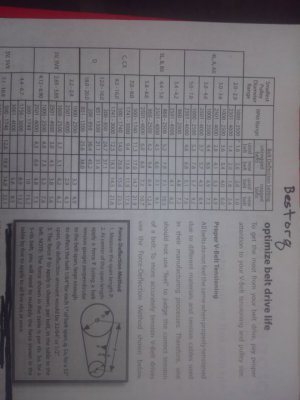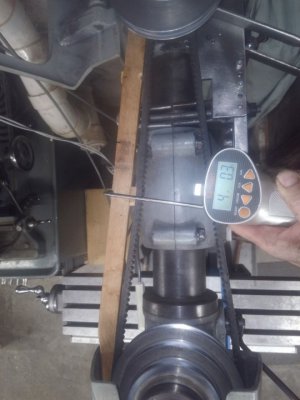I have been going down the rabbit hole on belt tension and thought I would share what I learned before I forget it. This is mostly from Gates and other belt company literature. A common statement is belts should be just tight enough so they do not slip. It took me a while to realize the belts were slipping on my machine, I initially thought I needed more HP when the end mill stopped spinning. Not sure if I would even know if it was only slipping a little?
There are several ways to measure belt tension. A common one is to measure the force it takes to deflect the belt by 1/64th of the belt span. The table from bestorque shows maximum recommended deflection force for various belt types and sheave diameters. Attached below is a photo of a printed downloaded table. A used belt is one that has been run for a few hours. Most applications will not need this high of a tension and it's possible the shafts and bearings were not designed to handle the maximum force. I have measured belt tension on my milling machine by cutting a straight stick of wood to be the same as the free length span of the belt and gluing a small block in the center that is 1/64 of the span (0.028"). I used a trigger pull scale to pull on the back of the stick until both ends contact the belt thus the center is deflected by the block thickness.


There are a bunch of calculations that can be used to predict the correct deflection. In general, the tension will need to increase as the transmitted HP increases, as the sheave size decreases and as the RPM decreases. I downloaded the free Gates calculator tool "design flex pro" to calculate the optimum deflection force for my Clausing 8520 that has 2 belts. There is also some quick documents with hints on using the program all found with a search.
The 3 slowest speeds use a 1.7" diameter pulley on the 3/4 hp motor. The program calculated the maximum rated load is only 0.5 hp so it might be reasonable to scale up to a 2" pulley size or a different type of belt. The same problem occurred with the spindle belt at 180 RPM. This probably also explains why the smallest pulleys are worn too wide. There was some measuring and trial and error to estimate what the original sizes of the sheaves were that results in the RPM on the machine label.
The program also calculates the total static belt pull, This would be the force you would have to push on the motor with before tightening the clamp bolts. Total static pull is between 22 and 13 lb for the motor and 19 to 109 lb for the spindle belt. This is way more than I can comfortably apply by pushing on the motor so I needed to use some kind of lever to tension the belts when running at the lowest 2 speeds. The correct belt tension is much higher than I would have guessed at the lower speeds and much looser at the higher speeds so I am glad I went through this exercise. Next up will be finishing the design and build of belt tensioning levers for the mill, I will aim for about a 10:1 ratio of the lever arm.
The program can also be used to design a new belt drive system given the desired HP, RPM, spacing etc. It will recommend number and types of belts, standard available sheave sizes. etc. There are other types of belts that can transmit the 3/4 hp with small sheaves but no plan to change that for now.
There are several ways to measure belt tension. A common one is to measure the force it takes to deflect the belt by 1/64th of the belt span. The table from bestorque shows maximum recommended deflection force for various belt types and sheave diameters. Attached below is a photo of a printed downloaded table. A used belt is one that has been run for a few hours. Most applications will not need this high of a tension and it's possible the shafts and bearings were not designed to handle the maximum force. I have measured belt tension on my milling machine by cutting a straight stick of wood to be the same as the free length span of the belt and gluing a small block in the center that is 1/64 of the span (0.028"). I used a trigger pull scale to pull on the back of the stick until both ends contact the belt thus the center is deflected by the block thickness.


There are a bunch of calculations that can be used to predict the correct deflection. In general, the tension will need to increase as the transmitted HP increases, as the sheave size decreases and as the RPM decreases. I downloaded the free Gates calculator tool "design flex pro" to calculate the optimum deflection force for my Clausing 8520 that has 2 belts. There is also some quick documents with hints on using the program all found with a search.
| AX Belt Deflection Force (lb) | |||
| RPM | Motor, 0.08" | Spindle, 0.28" | Max Hp |
| 180 | 1.5 | 3.5 | 0.5 |
| 350 | 1.5 | 2.2 | 0.5 |
| 600 | 1.5 | 1.6 | 0.5 |
| 1000 | 1 | 1.2 | 0.75 |
| 1900 | 1 | 0.92 | 0.75 |
| 3250 | 1 | 0.92 | 0.75 |
The 3 slowest speeds use a 1.7" diameter pulley on the 3/4 hp motor. The program calculated the maximum rated load is only 0.5 hp so it might be reasonable to scale up to a 2" pulley size or a different type of belt. The same problem occurred with the spindle belt at 180 RPM. This probably also explains why the smallest pulleys are worn too wide. There was some measuring and trial and error to estimate what the original sizes of the sheaves were that results in the RPM on the machine label.
The program also calculates the total static belt pull, This would be the force you would have to push on the motor with before tightening the clamp bolts. Total static pull is between 22 and 13 lb for the motor and 19 to 109 lb for the spindle belt. This is way more than I can comfortably apply by pushing on the motor so I needed to use some kind of lever to tension the belts when running at the lowest 2 speeds. The correct belt tension is much higher than I would have guessed at the lower speeds and much looser at the higher speeds so I am glad I went through this exercise. Next up will be finishing the design and build of belt tensioning levers for the mill, I will aim for about a 10:1 ratio of the lever arm.
The program can also be used to design a new belt drive system given the desired HP, RPM, spacing etc. It will recommend number and types of belts, standard available sheave sizes. etc. There are other types of belts that can transmit the 3/4 hp with small sheaves but no plan to change that for now.

